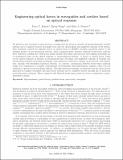Engineering Optical Forces in Waveguides and Cavities Based on Optical Response
Author(s)
Rakich, Peter T.; Wang, Zheng; Popovic, Milos
DownloadRakich-2010-Engineering optical.pdf (2.150Mb)
PUBLISHER_POLICY
Publisher Policy
Article is made available in accordance with the publisher's policy and may be subject to US copyright law. Please refer to the publisher's site for terms of use.
Terms of use
Metadata
Show full item recordAbstract
We present a new treatment of optical forces, revealing that the forces in virtually all optomechanically variable systems can be computed exactly and simply from only the optical phase and amplitude response of the system. This treatment, termed the response theory of optical forces (or RTOF), provides conceptual clarity to the essential physics of optomechanical systems, which computationally intensive Maxwell stress-tensor analyses leave obscured, enabling the construction simple models with which optical forces and trapping potentials can be synthesized based on the optical response of optomechanical systems. A theory of optical forces, based on the optical response of systems, is advantageous since the phase and amplitude response of virtually any optomechanical system (involving waveguides, ring resonators or photonic crystals) can be derived, with relative ease, through well-established analytical theories. In contrast, conventional Maxwell stress tensor methods require the computation of complex 3-dimensional electromagnetic field distributions; making a theory for the synthesis of optical forces exceedingly difficult. Through numerous examples, we illustrate that the optical forces generated in complex waveguide and microcavity systems can be computed exactly through use of analytical scattering-matrix methods. When compared with Maxwell stress-tensor methods of force computation, perfect agreement is found.
Date issued
2010-02Department
Massachusetts Institute of Technology. Research Laboratory of ElectronicsJournal
Proceedings of SPIE--the International Society for Optical Engineering; v.7579
Publisher
SPIE
Citation
Rakich, Peter T., Zheng Wang, and Milos A. Popovic. “Engineering optical forces in waveguides and cavities based on optical response.” Laser Resonators and Beam Control XII. Ed. Alexis V. Kudryashov, Alan H. Paxton, & Vladimir S. Ilchenko. San Francisco, California, USA: SPIE, 2010. 75790C-15.
©2010 COPYRIGHT SPIE--The International Society for Optical Engineering.
Version: Final published version
ISSN
0277-786X
Keywords
Optomechanics, optical forces, gradient forces, microcavity, waveguide